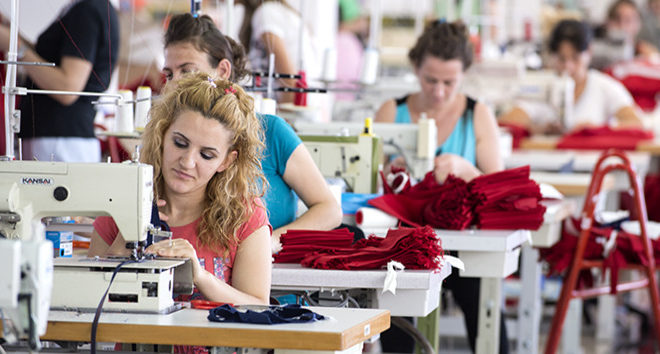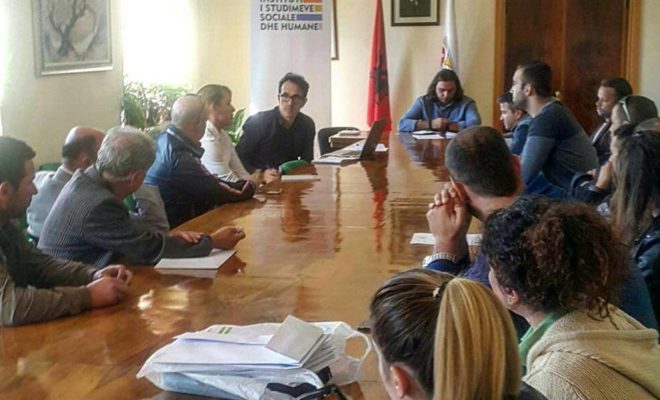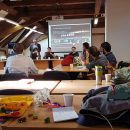The status of work in Albania: analysis of economic and social effects of the practices of self-employment

Policy Brief
Institute of social studies and humanities – Tirana
Authors: Artan Sadiku and Leart Kola

Self-employment is a poorly researched and analyzed field in the economies of the Balkan countries and consecutively its social and economic impact on the life of the self-employed is largely unknown. This becomes a significant challenge in the case of Albania where the last relevant data from the World Bank for the year of 2013 show that 60 percent[1] of the total number of workers in the country are self-employed. Compared to the region, the number of the self-employed in Albania is two to three times higher than that of the other countries, with Macedonia having 22, Serbia 28 and Croatia 12 percent.
The statistics at world level show that the developed countries have significantly lower rate of self-employment in comparison with the developing ones. This tendency can be related to a range of conditions that are a result of economic development such as higher salaries, advanced models of social, health and pension insurance, higher standards of protection at workplace, shortening of the working hours below eight hours a day etc. The countries of the European Union have a self-employment rate below 15 percent, while in the African countries this rate is above 70 percent.
In analyzing the issue of high self-employment in Albania, one must take into consideration the theoretical approaches to self-employment and also the historical developments of the economy of the country. In theory there are two main determining groups of factors[2] that impact the decision to become a self-employed person: (1) the push factors – that relate to bad conditions in the labor market, such as high unemployment, low salaries and bad working conditions that push the workers towards self-employment as an escape from being exposed to these conditions and (2) pull factors – relate to a thriving market where individuals see self-employment as a chance of realizing their personal and economic wishes better than in the jobs market.
Historically, Albania, similar to the other countries of the former ‘eastern bloc’, experienced a premature deindustrialization[3] under the pretext of achieving a better sectoral balance, thus reducing industry sector in favor of agriculture and services. In 1989, 40 percent of Albania’s GDP was produced by the industrial sector, while in 2004 this sector consisted of only 20 percent of the all the countries production. Such a sectoral change impacted the status of work and the character of employment in the country. With the shrinking of industry jobs, a sectors that is characterized with longer term contracts, stability of jobs and social security coverage as well as highly qualified skills of the employees, the workers ‘emigrated’ to the other sectors where jobs are instable and insecure. Consequently, Albania’s rate of employment in the industry sector (11.4%) is two to three times compared to that of Macedonia (29.6%), Serbia (25.5%) and Croatia (27.6%).
Thus, self-employment in Albania occurs as the dominant mode of employment in the services and agriculture sectors and its high level is directly related to the risk of unemployment. In the countries with similar economic indicators and which have lower self-employment rate, they usually have a higher level of unemployment – the case of Macedonia. While self-employment in Albania contributes to the lowering of the number of the unemployed, the character of the economic activity of the self-employed and the side-effects related to it are largely disadvantageous for the workers belonging to this group. Thus, the damaging socio-economic relation between the unemployment and self-employment cannot be tackled without structural sectoral rearrangements towards expanding of the industry.
While only 35 percent of Albania’s workers are engaged in salary jobs, majority of the ones who are self-employed are engaged in unpaid family work. Of the total number of the active workforce in the country, the unpaid family workers represent the largest group – 37 percent. The largest majority of them are active in the agricultural sector and in the small trade sector. At this point, a significant gender aspect strikes as a pattern of a relevant importance to the analysis. In the lower developed countries, and those with still traditional family relations, it is usually the women that suffer the consequences of their informal work. In Albania, the data related to the possibility of ending up in unpaid family work are two times higher for women – 52 percent, rather than for man – 25 percent.[4] This means that the risk to being exposed to negative socio-economic effects for the women is two times higher than for men. When we take into consideration the traditional modes of gender relations, such a relation in percentages contributes to the continuity of financial dependency of women and an increased exposure to the conditions of lack of social and health insurance.
The higher rate of engagement of women as unpaid family workers impacts negatively in their domestication within the home environment that disables their access to practices that support the development of their skills. The prolonging of the period of engagement in unpaid family work, makes this social group chronically unable for inclusion in the labor market through formal employment.
Another aspect that is interrelated with the high self-employment in the country is the low level of syndical activity. While at one hand, the weak activity of labor unions and the mistrust towards them among the workers results in a weak protection of workers’ rights and interests, which pushes workers towards self-employment, on the other hand, a high level of self-employed workers contributes to a low level of membership in the labor unions. With around 60 percent of the workers being employed by themselves, the number of those who have salary contracts and thus could organize in unions is significantly lower than in other countries with a lower number of self-employed. Therefore, this correlation between syndical activity and self-employment should be reversed through tackling both these problems at the same time. An improved labor union organizing should go hand in hand with incentivizing the crossing form non-formal to formal employment of workers through a variety of long term economic policies.
The low income that the self-employed generate through their economic activity is another chronic problem with this dominant mode of employment in Albania. In 2015, 45 percent of the self-employed in the country have been active through small trade enterprise, usually small shops and kiosks. The figures from a World Bank report[5] point to another endemic problem of the Albania’s workforce, which has the largest low qualified portion in all the region (48.7%), thus workers are pushed to escape unemployment through engaging in non-productive and low income economic activities such as small trade. In the period between 2013 and 2015, there has been a very high increase in small trade enterprises which points to the problem of increased competition and consequently a decreasing income. While the number of self-employed enterprises in small trade increased in the given period with 46 percent, the general income of all of them in the same period increased only with 6.5 percent (data received from Instat.gov.al).
The problem of the low income of the self-employed reveals a potential for another major problem which at present is not visible through the official data of the relevant institutions in Albania. That is the scale of poverty hitting the self-employed, which according to the other existing data might be the most serious problem with the trends of self-employment in the country. The problem of poverty among the self-employed is one crucial issue in the UK, where the Tax Research organization has estimated that around 80 percent of the self-employed in Britain live below the poverty line.[6] The same research shows that the self-employed generate approximately 40 percent less income than the ones employed with a regular salary contract. At European Union level, there are 25 percent of self-employed who live below the poverty line. There is an urgent need for Albanian institutions to improve their data-processing capacities and policies in order to be able to determine the scale of the poverty problem among the self-employed and thus adequate social and labor market policies put in place.
Being exposed to the risk of poverty in a larger scale than the regularly employed ones, the self-employed workers also face the risk of remaining outside of the social and healthcare protection nets. The comparison of data for the self-employed in the country and those from the Institute of social insurances shows that around 20% of the self-employed in Albania do not pay their social benefits. This is a direct result of the low level of income that these workers generate from their independent activity.
In general, self-employment can be viewed as positive practice from the standpoint that it represents an economic activity that avoids the traditional exploitation of salaried workers especially in countries where worker’s protection is chronically insufficient. But, in the present economic conditions in Albania, aiming to escape exploitation at workplace only leads to an increased exposure to poverty, insecurity, increased self-exploitation, extended working hours and lack of proper health, social and pension insurance. Thus, the Albanian government must immediately start planning for structural adjustments to its economy, through market intervention, and come to the service of its population by increasing the industrial sector. Intervening in the market is a practice that European countries, such as Germany[7], have applied in order to control the consequences in times of socio-economic crisis, and the Albanian government should tackle the pertaining crisis in the labor market through such interventions.
Only with new investments in industry and its supporting infrastructure, new stabile jobs can be created and a path of transition from non-formal to formal employment can be incentivized for the majority of workers exposed to the danger of self-employment in the country. On the other hand, there is also a need to intervene in the discursive and media reproduction of the ide of “being your own boss” and the supporting of the individual entrepreneurship spirit. All the relevant data for the country show that this is an extremely bad choice, which actually in the concrete Albanian context occurs more as a means to escape unemployment rather than realizing some successful economic idea. In the current market conditions, escaping the exploitative work practices can only be achieved through the collective action of organized workers and not via individual ‘escapes’ that lead to a vortex of extreme socio-economic consequences.
At the level of public discourse, there is a need to cease the reproducing of the positive image on self-employment as a successful and independent mode of economic activity, since Albania already has a high level of self-employment which causes a range of social consequences. Only in limited areas such as ‘smart self-employment’ in the IT technology business and other areas with high demand in the market and with a high efficiency and income, the government and other actors should engage in supporting and enabling a better environment for self-employment.
Most importantly, new process of planning for long-term policies on restructuring the country’s economy must take place within the Albanian government. The increase of the industry sector, which generates stable and long-term jobs, should be achieved through subsidies, initial tax advantages and improvement of the supporting infrastructure for the investments in the industry, where priority should be given to the production sectors and not the service ones. Foreign investments should be negotiated in due respect of environmental and labor standards in order to avoid the negative consequences from such investments as experienced in Macedonia and Serbia.[8] New industry jobs will also contribute to the decrease of the informality in the labor market, because it will open a opportunities for transferring of many workers into formal contractual employment.
The agricultural sector which in the last years has been performing well (in 2015 its exports increased by 6 percent) could perform much better given that policies that support the setting up of agricultural cooperatives are put in place. With around 42 percent of the total number of workers, the agricultural sector remains highly fragmented among individual farmers. There are many European instruments on agricultural cooperatives[9] that can be utilized in the pre-accession process in order to support the Albanian farmers to join their resources, increase technological investments and improve their exporting capacities.
Finally, in order to improve the policies in the labor market in Albania, there should be better practices for data gathering and processing put in place. Specialized institutions such as INSTAT should increase their capacities in term of human resources but also in terms of tools and mechanisms used in their everyday work, but also other institutions should be equipped with instruments to gather and collect the data that they generate in the curse of their everyday work. A better institutional coordination is needed in order to integrate and improve the synergies among the policies in the labor market, education and vocational training policies as well as those on investments.
The full version of the publication can be found in albanian language at the following link:
http://issh.al/wp-content/uploads/2017/12/STATUSI-I-PUNS-N-SHQIPRI-draft-final1.pdf
[1] Self-employed, total (% of total employment). Source: https://data.worldbank.org/indicator/SL.EMP.SELF.ZS?locations=AL
[2] Christopher, D et al. Why Do Individuals Choose Self-Employment? Discussion Paper Series, Forschungsinstitut zur Zukunft der Arbeit January 2009. Available at: http://ftp.iza.org/dp3974.pdf
[3] Milica Uvalić, “Structural weaknesses of the Western Balkan economies”, http://www.suedosteuropa.uni-graz.at/biepag/node/92
[4] National Strategy for Employment and training 2014-2020. Available at: http://shtetiweb.org/2014/02/27/strategjise-kombetare-per-punesim-e-aftesi-2014-2020/?print=pdf
[5] Word Bank Group. Vienna Institute for International Economic Studies. April, 2017. “Western Balkans Labor Market Trends 2017”. Available at: http://pubdocs.worldbank.org/en/336041491297229505/170403-Regional-Report-Western-Balkan-Labor-Market-Trends-2017-FINAL.pdf
[6] The self employed’s income – new data shows 77% are in poverty. January, 2015. Available at:
[7] Spiegel. January 2009.” The State as Über-Entrepreneur. Berlin Sees No Limits to Economic Intervention.” http://www.spiegel.de/international/business/the-state-as-ueber-entrepreneur-berlin-sees-no-limits-to-economic-intervention-a-602632.html
[8] Deutsche Welle: Investor paradise Macedonia is a nightmare for workers. Available at: http://www.dw.com/en/investor-paradise-macedonia-is-a-nightmare-for-workers/a-19454696
[9] Agri-cooperatives in the EU. Available at: https://ec.europa.eu/agriculture/sites/agriculture/files/agri-markets-task-force/contributions/concrete/copacogecaagricooperatives_en_.pdf








